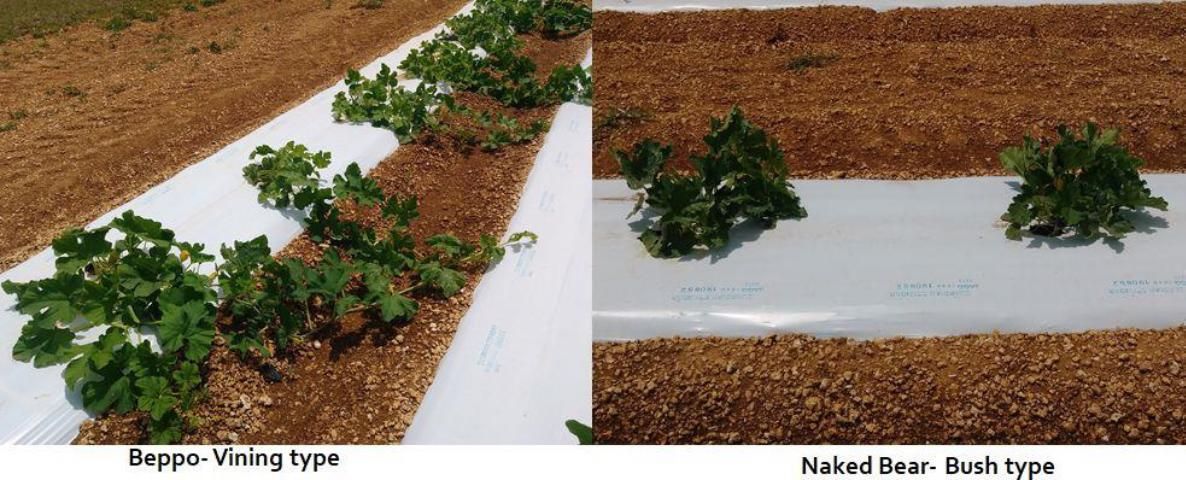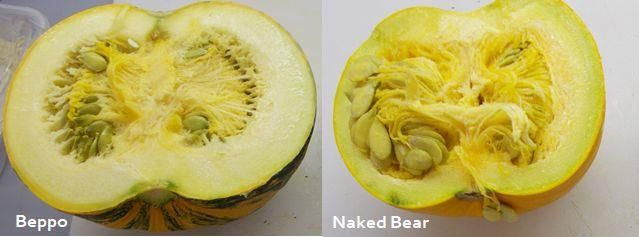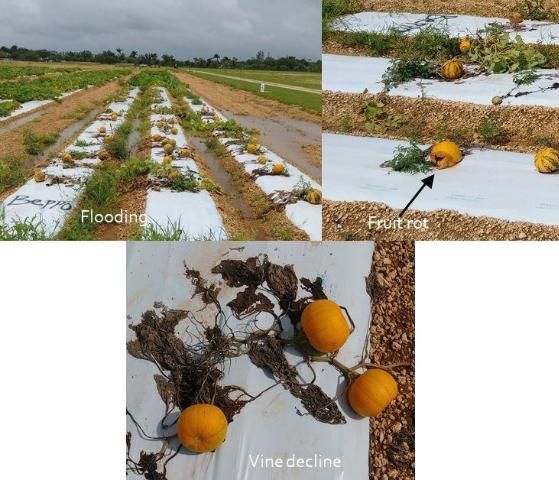Introduction
Pumpkin (Cucurbita pepo L.) seeds with a thin or soft seed coat are called naked seeds. Naked pumpkin seeds are a popular ingredient in many snacks, breads, breakfast cereals, soups, and other edible goods (Baxter et al. 2012; Loy 2004). Vegetable oil derived from the seeds can be purchased by the bottle for culinary/condiment use or as capsules in health food stores (Stevenson et al. 2007). Unlike conventional hulled pumpkin seeds, naked seeds lack a complete seed coat, and thus are preferred for snacking and oil production because they eliminate the need for manual de-hulling prior to use. Popularity of naked-seed products is expected to increase in the US as the market for healthy foods increases. Pumpkin seeds are rich in oil (50% w/w), protein (35%), unsaturated fatty acids (86%) (Meru et al. 2018), and antioxidants that have many health benefits, including a reduced risk of certain cancers (Lelley et al. 2009; Nesaretnam et al. 2007; Stevenson et al. 2007), treatment of enlarged prostate, and lowering cholesterol levels (Fruhwirth and Hermetter 2007; Thompson and Grundy 2005). Despite growing popularity of pumpkin seeds in the US, the majority of naked seeds consumed in the US are imported; hence, the need to identify/develop cultivars adapted to local growing conditions. This article reports on yield and horticultural performance of two naked-seed pumpkin cultivars under south Florida (Miami-Dade County) spring growing conditions.
Methodology
Two hybrid naked-seed cultivars, 'Beppo' and 'Naked Bear', were sourced from Territorial Seed Company. 'Beppo' (100 days to maturity) is marketed as a dual-purpose cultivar for seed/oil consumption and ornamental purposes. 'Naked Bear' (105 days to maturity) is marketed as a dual-purpose cultivar for seed/oil and flesh consumption. Seeds for both cultivars were sown on March 5, 2018, in cells filled with Fafard 3B soil amended with Osmocote Classic (0.05 oz/lb N, 0.05 oz/lb P, 0.05 oz/lb) in the greenhouse. After three weeks, the seedlings were transplanted into plastic mulch beds with a 4 ft in-row spacing in a field at the UF/IFAS Tropical Research and Education Center (TREC) in Homestead, Florida. The cultivars were evaluated using a randomized complete block design consisting of three plots, each plot with 10 plants. Fertilizer (3-0-10, 150 lb/acre N) was applied weekly via drip fertigation for the duration of the experiment. Weekly pest management was conducted following recommendation for cucurbits in the 2017‒2018 Vegetable Production Handbook of Florida (https://edis.ifas.ufl.edu/cv292). Data were collected on growth habit (bush or vining), flowering time (days to male or female flowering), fruit quality (weight), and yield (fruit and seed). Fruits were harvested at 91 days after planting. Data were analyzed using the GLM procedure of SAS (SAS Institute Inc., Cary, NC).
Findings
A. Growth Habit
The two cultivars exhibited distinctly different growth habits. 'Beppo' had long vines, while 'Naked Bear' had short vines, also described as bush type (Figure 1).

Credit: Geoffrey Meru
Although a 4-foot-long in-row spacing was adequate for both cultivars in the current study, growers may increase the planting density for 'Naked Bear' due to it's bush type habit. Space optimization for both cultivars will need further investigation in future trials.
B. Flowering Time
Days to male flowering (DTM). Male flowers for 'Beppo' (41.9 DTM) opened significantly earlier than those of 'Naked Bear' (44.6 DTM), an average of 2.7 days sooner (Table 1).
Days to female flowering (DTF). Similarly, 'Beppo' (47.7 DTF) was significantly earlier in female flowering than 'Naked Bear' (50.8 DTF), with an average difference of 3.1 DTF (Table 1). DTF is an important indicator of earliness and determines harvest time for growers. An early harvest would mean less competition in the market, and thus may earn better prices for growers. Although 'Naked Bear' flowered later than 'Beppo', the difference was small (less than 5 days) and would not affect the marketing window for seeds, which can be harvested and stored for a long time.
C. Fruit and Seed Yield
The fruit load on 'Naked Bear' plants ranged from 1 fruit per plant to 4 fruits per plant, with a mean fruit yield of 2.3 fruits per plant (Table 1). This yield was significantly higher than that for 'Beppo', which had a mean yield of 1.3 fruits per plant and a range of 1 to 2 fruits per (Table 1). Seed yield per fruit ranged from 246 to 361 for 'Beppo', and 177 to 398 for 'Naked Bear'. The average seed yield per fruit in 'Beppo' (313.5) did not significantly differ from that of 'Naked Bear' (274.1) (Table 1). However, based on the difference in fruit yield per plant between 'Beppo' (1.3 fruits per plant) and 'Naked Bear' (2.3 fruits per plant), it is expected that overall seed yield per plant would be much higher in 'Naked Bear'.
To enhance yield of the bush-type 'Naked Bear', growers can increase the planting density in the field. For example, one acre of 'Naked Bear' planted at 4-foot-long in-row spacing (24 square ft per plant) would accommodate 1,815 plants per acre and yield 1.14 million seeds, equivalent to 676 lbs of seeds per acre. Using a 1-foot-long in-row spacing (6 square ft per plant) would allow 7,260 plants per acre and a seed yield of 4.56 million, equivalent to 2,704 lbs of seeds per acre. This yield is comparable to that reported for naked-seed pumpkin cultivars in Oregon (1,006–2,848 lbs of seeds per acre), using a 5 square ft area per plant (Buhrig 2017). 'Beppo' fruits were significantly larger in weight, length, width, and flesh diameter than those of 'Naked Bear' (Table 1). Fruit weight for 'Beppo' ranged from 4.72 lbs to 7.72 lbs, while that of 'Naked Bear' ranged from 0.99 lbs to 1.90 lbs, with a mean fruit weight of 6.17 lbs and 1.32 lbs, respectively (Table 1).
D. Seed Characteristics
At harvest, seeds of both cultivars appeared to have similar physical characteristics (Figure 2A). However, upon drying at room temperature for 4 days, the majority of 'Naked Bear' seeds had a thin coat (Murovec 2015) surrounding them, that was not observed on 'Beppo' seeds (Figure 2B).

Credit: Geoffrey Meru
The naked-seed trait is conferred by a single recessive mutation that leads to significant reduction in the amounts of lignin and cellulose in the hypodermis, sclerenchyma, and parenchyma tissues of the seed coat (Fruhwirth and Hermetter 2007). Depending on the level of lignification or cellulose in the seed coat, several types of seed phenotypes may form (Murovec 2015; Meru et al. 2017). Overall, naked pumpkin seeds are preferred for snacking and oil production because they eliminate the need for manual de-hulling prior to use.
The average 25-seed weight for 'Beppo' was significantly higher than that of 'Naked Bear' (Table 1). This is particularly important for seed oil yield, which is a function of seed weight. Therefore, growers would get more oil per seed from 'Beppo' than 'Naked Bear'. However, 'Naked Bear' may compensate for this difference with its higher seed yield per plant.
E. Fruit Characteristics and Flavor Assessment
'Beppo' had round fruits with orange-colored skin that were heavily ridged with contrasting green stripes (Figure 3). Fruits of 'Naked Bear' were small and round with a solid orange skin color (Figure 3).

Credit: Geoffrey Meru
Flesh of 'Beppo' fruits was cream-white in color, while 'Naked Bear' had a light yellow flesh (Figure 4).

Credit: Geoffrey Meru
A local chef in Miami-Dade County performed preliminary assessments of seed and flesh flavor. Roasted seeds of both cultivars were rated as good, indicating their potential in the snack and culinary market. 'Beppo' flesh was described as bland with a bitter aftertaste, while 'Naked Bear' flesh was described as lacking a depth of flavor and tasting like zucchini summer squash. These results confirm general observation of poor flesh quality in naked-seed pumpkin cultivars (Baxter et al. 2012; Loy 2004) and highlight the need to develop superior flesh naked-seed cultivars.
Conclusions
'Naked Bear' was superior in fruit number per plant. Although the seed number per fruit for the two cultivars did not differ significantly, higher number of fruits per plant in 'Naked Bear' may result in higher seed yield per acre. The seeds of 'Beppo' were larger (seed weight) and devoid of a thin membranous seed coat that was present in 'Naked Bear' seeds. The seeds for both cultivars were flavorful; however, their flesh lacked desirable flavor. Flesh quality in both cultivars may have been affected by a 10‒15 days earlier harvest than was recommended. However, an early harvest was necessary in the current study due to heavy rainfall in the months of May and June 2018, which led to vine decline and fruit rot (Figure 5).

Credit: Geoffrey Meru
Given this challenge, it is recommended that growers transplant early to mid-February, and harvest in late April/early May to avoid onset of heavy rainfall (Stephens 2015). Alternatively, growers should consider growing the crop in fall season, which is less prone to heavy rainfall compared to summer. Evaluation of whether fruit and seed yield may be improved by optimizing plant spacing and providing bees to aid pollination will be the subject of future studies.
Breeding for Dual-Purpose Pumpkins at TREC
There is need for dual-purpose pumpkins that can be used for production of naked seeds and sweet edible flesh. The University of Florida cucurbit-breeding program, located at TREC, is making headway in developing high-yielding and nutritious dual-purpose pumpkins adapted to south Florida's tropical climate using traditional and contemporary (marker-assisted selection) breeding approaches. Once available, these cultivars will be integral to promoting a niche industry for specialty pumpkins in south Florida.
References
Baxter, G. G., K. Murphy, and A. Paech. 2012. "The Potential to produce pumpkin seed for processing in north east Victoria". Rural Industries Development Corporation. 11/145:5–36.
Buhrig, W. H. 2017. "Can pumpkins be grown competitively for snack seed purposes in Malheur County?" Agricultural Research Foundation, Oregon State University. 1‒6
Fruhwirth, G. O., and A. Hermetter. 2007. "Seeds and oil of the Styrian oil pumpkin: Components and biological activities." Eur. J. Lipid Sci. Technol. 109: 1128–1140.
Lelley, T., B. Loy, and M. Murkovic. 2009. "Hull-Less oil seed pumpkin." In J. Vollmann and I. Rajcan (eds.), Oil Crops, Handbook of Plant Breeding. DOI 10.1007/978-0-387-77594-4_16.
Loy, J. B. 2004. "Morpho-physiological aspects of productivity and quality in squash and pumpkins Cucurbita (spp.)." Critical Reviews Plant Sci. 23: 337–363.
Meru, G., Y. Fu, D. Leyva, P. Sarnoski, and Y. Yagiz. 2018. "Phenotypic relationships among oil, protein, fatty acid composition and seed size traits in Cucurbita pepo." Sc. Hort. 233: 47‒53.
Meru, G., Y. Fu, D. Leyva, P. Sarnoski, and Y. Yagiz. 2017. Health benefits of pumpkin seed and nutrition profile of 35 pumpkin accessions. HS1312. Gainesville: University of Florida Institute of Food and Agricultural Sciences. https://edis.ifas.ufl.edu/hs1312
Murovec, J. 2015. "Phenotypic and genetic diversity in pumpkin accessions with mutated seed 302 coats." HortScience 50: 211–217.
Nesaretnam, K., P. A Gomez, K. R. Selvaduray, and G. A. Razak. 2007. "Tocotrienol levels in adipose tissue of benign and malignant breast lumps in patients in Malaysia. Asia." J. Clin. Nutr. 16: 498–504.
Stephens, J. M. 2015. Pumpkin, Naked-Seeded- Cucurbita pepo L. HS650. Gainesville: University of Florida Institute of Food and Agricultural Sciences. https://edis.ifas.ufl.edu/mv117
Stevenson, D. G., F. J. Eller, L. Wang, J. L. Jane, T. Wang, and G. E. Inglett. 2007. "Oil and tocopherol content and composition of pumpkin seed oil in 12 cultivars." J. Agric. Food Chem. 55: 4005–4013.
Thompson, G. R., and S. M. Grundy. 2005. "History and development of plant sterol and stanol esters for cholesterol-lowering purposes." Am. J. Cardiol. 96: 3D–9D.